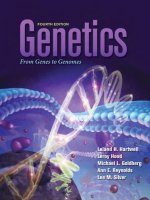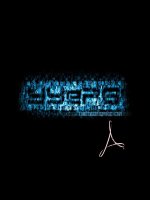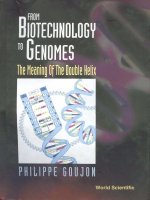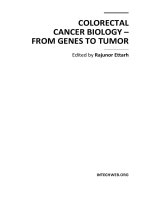GeneticsFrom Genes to Genomes Chap5
Bạn đang xem bản rút gọn của tài liệu. Xem và tải ngay bản đầy đủ của tài liệu tại đây (13.12 MB, 59 trang )
<span class='text_page_counter'>(1)</span>PowerPoint to accompany. Genetics: From Genes to Genomes Fourth Edition Leland H. Hartwell, Leroy Hood, Michael L. Goldberg, Ann E. Reynolds, and Lee M. Silver. Prepared by Mary A. Bedell University of Georgia. Copyright © The McGraw-Hill Companies, Inc. Permission required to reproduce or display. 1.
<span class='text_page_counter'>(2)</span> PART I Basic Principles: How Traits Are Transmitted. CHAPTER. CHAPTER CHAPTER CHAPTER. Linkage, Recombination and the Mapping of Genes on Chromosomes. CHAPTER OUTLINE 5.1 Gene Linkage and Recombination 5.2 The Chi-Square Test and Linkage Analysis 5.3 Recombination: A Result of Crossing-Over During Meiosis 5.4 Mapping: Locating Genes Along a Chromosome 5.5 Tetrad Analysis in Fungi 5.6 Mitotic Recombination and Genetic Mosaics Copyright © The McGraw-Hill Companies, Inc. Permission required to reproduce or display Hartwell et al., 4th ed., Chapter 5. 2.
<span class='text_page_counter'>(3)</span> Gene linkage and recombination Genes linked together on the same chromosome usually assort together Linked genes may become separated by recombination Two themes in this chapter: 1.Further apart two genes are, the greater the probability of recombination 2.Recombination data can be used to generate maps of relative locations of genes on chromosomes. Copyright © The McGraw-Hill Companies, Inc. Permission required to reproduce or display Hartwell et al., 4th ed., Chapter 5. 3.
<span class='text_page_counter'>(4)</span> Detecting linkage by analyzing the progeny of dihybrid crosses: X-linked genes Syntenic genes – genes located on the same chromosome Two X-linked genes in Drosophila with recessive alleles • w+ (red eyes) and w (white eyes) • y+ (brown body) and y (yellow body) Note that in this cross: F1 males get their only X chromosome from their mothers F1 females are dihybrids Fig. 5.2a Copyright © The McGraw-Hill Companies, Inc. Permission required to reproduce or display Hartwell et al., 4th ed., Chapter 5. 4.
<span class='text_page_counter'>(5)</span> Detecting linkage by analyzing the progeny of dihybrid crosses: X-linked genes (cont) Compare allele configurations in F2 to P generation Deviation from 1:1:1:1 segregation in F2 indicates the genes are linked Note that in this cross involving X-linked genes, only the F2 male progeny were counted Fig. 5.2b Copyright © The McGraw-Hill Companies, Inc. Permission required to reproduce or display Hartwell et al., 4th ed., Chapter 5. 5.
<span class='text_page_counter'>(6)</span> Designation of "parental" and "recombinant" relate to past history Note that the parental configurations in these two crosses are opposite of each other. Fig. 5.3 Copyright © The McGraw-Hill Companies, Inc. Permission required to reproduce or display Hartwell et al., 4th ed., Chapter 5. 6.
<span class='text_page_counter'>(7)</span> Autosomal genes can also exhibit linkage Detect linkage by generating a double heterozygote and crossing to homozygous recessive (testcross). Fig. 5.4 Copyright © The McGraw-Hill Companies, Inc. Permission required to reproduce or display Hartwell et al., 4th ed., Chapter 5. 7.
<span class='text_page_counter'>(8)</span> Chi square test pinpoints the probability that ratios are evidence of linkage Deviations from 1:1:1:1 ratios can represent chance events or linkage Chi square test measures "goodness of fit" between observed and expected values Null hypothesis – observed values are no different from expected values • In linkage studies, the null hypothesis is no linkage • If genes are linked, expect 1:1:1:1 ratio in F2 progeny • Chi-square test can reject the null hypothesis, but it cannot prove a hypothesis Copyright © The McGraw-Hill Companies, Inc. Permission required to reproduce or display Hartwell et al., 4th ed., Chapter 5. 8.
<span class='text_page_counter'>(9)</span> Information needed for the chi-square test. Use data from breeding experiment • Total number of progeny • How many classes of progeny • Number of offspring observed in each class Calculate number of offspring expected in each class if there is no linkage (1:1:1:1 segregation). Copyright © The McGraw-Hill Companies, Inc. Permission required to reproduce or display Hartwell et al., 4th ed., Chapter 5. 9.
<span class='text_page_counter'>(10)</span> . Applying the chi-square test Calculate the chi-square 2 2 (no. observed no. exp ected) (O E) 2 no. expected E. Consider degrees of freedom (df) in the experiment • df = N – 1 (where N is the number of classes) Determine a p value using chi-square value and df • Probability that the deviation from expected numbers had occurred by chance • Use table 5.1 Copyright © The McGraw-Hill Companies, Inc. Permission required to reproduce or display Hartwell et al., 4th ed., Chapter 5. 10.
<span class='text_page_counter'>(11)</span> Applying the chi-square test to see if genes A and B are linked. Fig. 5.5. Experiment 1:. (O E)2 (31 25)2 (19 25)2 1.44 1.44 2.88 E 25 25. Experiment 2:. (O E)2 (62 50)2 (38 50)2 2.88 2.88 5.76 E 50 50. . 2. 2. Copyright © The McGraw-Hill Companies, Inc. Permission required to reproduce or display Hartwell et al., 4th ed., Chapter 5. 11.
<span class='text_page_counter'>(12)</span> Critical chi-square values Use p value of 0.05 as cutoff Chi-square values that lie in the yellow region of this table allow rejection of the null hypothesis with >95% confidence If null hypothesis is rejected, then linkage can be postulated. Copyright © The McGraw-Hill Companies, Inc. Permission required to reproduce or display Hartwell et al., 4th ed., Chapter 5. Table 5.1 12.
<span class='text_page_counter'>(13)</span> Recombination: A result of crossing-over during meiosis Frans Janssens – 1909, observed chiasmata at chromosomes during prophase of meiosis I T. H. Morgan – suggested chiasmata were sites of chromosome breakage and exchange H. Creighton and B. McClintock (corn) and C. Stern (Drosophila) – 1931, direct evidence that genetic recombination depends on reciprocal exchanged of chromosomes • Physical markers were used to identify specific chromosomes • Genetic markers were used as points of reference for recombination Copyright © The McGraw-Hill Companies, Inc. Permission required to reproduce or display Hartwell et al., 4th ed., Chapter 5. 13.
<span class='text_page_counter'>(14)</span> Evidence that recombination results from reciprocal exchanges between homologous chromosomes. Fig. 5.6 Copyright © The McGraw-Hill Companies, Inc. Permission required to reproduce or display Hartwell et al., 4th ed., Chapter 5. 14.
<span class='text_page_counter'>(15)</span> Recombination during meiosis I visualized by light microscopy. Early prophase. Leptotene and zygotene. Diplotene Fig. 5.7 Copyright © The McGraw-Hill Companies, Inc. Permission required to reproduce or display Hartwell et al., 4th ed., Chapter 5. 15.
<span class='text_page_counter'>(16)</span> Recombination during meiosis I visualized by light microscopy (cont) Terminalization – movement of chiasmata. Anaphase – chromosome separation occurs after chiasmata reach the telomeres Two recombinant and two parental gametes are produced Copyright © The McGraw-Hill Companies, Inc. Permission required to reproduce or display Hartwell et al., 4th ed., Chapter 5. Fig. 5.7 16.
<span class='text_page_counter'>(17)</span> Recombination frequencies are the basis of genetic maps A. H. Sturtevant – proposed that recombination frequencies (RF) could be used as a measure of physical distance between two linked genes 1 percent recombination = 1 RF = 1 map unit (m.u.) – 1 centiMorgan (cM). Fig. 5.8. Copyright © The McGraw-Hill Companies, Inc. Permission required to reproduce or display Hartwell et al., 4th ed., Chapter 5. 17.
<span class='text_page_counter'>(18)</span> Properties of linked versus unlinked genes. Table 5.2. Copyright © The McGraw-Hill Companies, Inc. Permission required to reproduce or display Hartwell et al., 4th ed., Chapter 5. 18.
<span class='text_page_counter'>(19)</span> Mapping genes by comparisons of two-point crosses Left-right orientation of map is arbitrary Most accurate maps obtained by summing many small intervening distances. Fig. 5.9 Copyright © The McGraw-Hill Companies, Inc. Permission required to reproduce or display Hartwell et al., 4th ed., Chapter 5. 19.
<span class='text_page_counter'>(20)</span> Limitations of two point crosses. Difficult to determine gene order if two genes are close together Actual distances between genes do not always add up Pairwise crosses are time and labor consuming. Copyright © The McGraw-Hill Companies, Inc. Permission required to reproduce or display Hartwell et al., 4th ed., Chapter 5. 20.
<span class='text_page_counter'>(21)</span> Three point crosses provide faster and more accurate mapping Testcross of triply-heterozygous F1. Fig. 5.10 Copyright © The McGraw-Hill Companies, Inc. Permission required to reproduce or display Hartwell et al., 4th ed., Chapter 5. 21.
<span class='text_page_counter'>(22)</span> Analyzing the results of a three-point cross Testcross progeny have four sets of reciprocal pairs of genotypes • Most frequent pair has parental configuration of alleles • Least frequent pair results from double crossovers • Examination of double crossover class reveals which gene is in the middle. Fig. 5.10 Copyright © The McGraw-Hill Companies, Inc. Permission required to reproduce or display Hartwell et al., 4th ed., Chapter 5. 22.
<span class='text_page_counter'>(23)</span> Inferring the location of crossover event. Examine numbers of progeny Compare configuration of alleles at two genes at a time to parental configuration. Fig. 5.11a. Copyright © The McGraw-Hill Companies, Inc. Permission required to reproduce or display Hartwell et al., 4th ed., Chapter 5. 23.
<span class='text_page_counter'>(24)</span> Inferring the location of crossover events (cont). Fig. 5.11b-d. Copyright © The McGraw-Hill Companies, Inc. Permission required to reproduce or display Hartwell et al., 4th ed., Chapter 5. 24.
<span class='text_page_counter'>(25)</span> Genetic map deduced from three-point cross in Figure 5.10 vg - b distance =. (252 + 241+ 131+ 118) x 100 17.7 4197. vg - pr distance =. (252 + 241+ 13 + 9) x 100 12.3 4197. (131+ 118 + 13 + 9) b - pr distance = x 100 6.4 4197. Fig. 5.10b Copyright © The McGraw-Hill Companies, Inc. Permission required to reproduce or display Hartwell et al., 4th ed., Chapter 5. 25.
<span class='text_page_counter'>(26)</span> . . Correction for double crossovers This calculation isn't accurate because it fails to account for double crossovers vg - b distance. (252 + 241+ 131+ 118) x 100 17.7 4197. Correct calculation that accounts for double crossovers vg - b distance. (252 + 241+ 131+ 118 + 13 + 13 + 9 + 9) x 100 18.7 4197. Copyright © The McGraw-Hill Companies, Inc. Permission required to reproduce or display Hartwell et al., 4th ed., Chapter 5. 26.
<span class='text_page_counter'>(27)</span> Interference: The number of double crossovers may be less than expected Chromosomal interference – occurrence of crossover in one portion of a chromosome interferes with crossover in an adjacent part of the chromosome Not uniform between chromosomes or within a chromosome Compare observed and expected frequencies of double crossovers (DCO) Coefficient of coincidence =. observed DCO frequency expected DCO frequency. Interference = 1 - coefficient of coincidence . Copyright © The McGraw-Hill Companies, Inc. Permission required to reproduce or display Hartwell et al., 4th ed., Chapter 5. 27.
<span class='text_page_counter'>(28)</span> Calculation of interference in the three-point cross in Figure 5.10 Expected probability of double crossovers is the product of the single crossover frequencies in each interval • Probability of single crossover between vg and pr is 0.123 (12.3 m.u.) • Probability of single crossover between pr and b is 0.064 (6.4 m.u.) If interference = 0, crossovers in adjacent regions occur independently of each other If interference = 1, no double crossovers occur Copyright © The McGraw-Hill Companies, Inc. Permission required to reproduce or display Hartwell et al., 4th ed., Chapter 5. 28.
<span class='text_page_counter'>(29)</span> Calculation of interference in the three-point cross in Figure 5.10 (cont) Expected probability of double crossovers 0.123 x 0.064 0.0079 = 0.79%. . Observed proportion of double crossovers . 13 9 x 100 0.52% 4197. 0.52 Coefficient of coincidence = 0.66 0.79 Interference 1 0.66 0.34 Copyright © The McGraw-Hill Companies, Inc. Permission required to reproduce or display Hartwell et al., 4th ed., Chapter 5. 29.
<span class='text_page_counter'>(30)</span> Do genetic maps correlate with physical reality? Order of genes revealed by genetic mapping corresponds to the actual order of genes along the chromosome Actual physical distance (amount of DNA) does not always show direct correspondence to genetic distance •Double, triple, and more crossovers •50% limit on observable recombination frequency •Non-uniform recombination frequency across chromosomes •Mapping functions compensate for some inaccuracies •Recombination rates differ between species Copyright © The McGraw-Hill Companies, Inc. Permission required to reproduce or display Hartwell et al., 4th ed., Chapter 5. 30.
<span class='text_page_counter'>(31)</span> Drosophila melanogaster has four linkage groups When many genes per chromosome have been mapped, a linkage group is synonymous with a chromosome. Fig. 5.13 Copyright © The McGraw-Hill Companies, Inc. Permission required to reproduce or display Hartwell et al., 4th ed., Chapter 5. 31.
<span class='text_page_counter'>(32)</span> Tetrad analysis in fungi Two model organisms for understanding mechanisms of recombination • Saccharomyces cerevisiae – bakers yeast • Neurospora crassa – bread mold All four haploid products of each meiosis are contained within an ascus (sac) Ascospores (haplospores) can germinate and survive as viable haploids that divide by mitosis Tetrad - four ascospores in a single ascus Haploid strains of opposite mating type (a and α) can be mated and the resulting diploid induced to undergo meiosis Copyright © The McGraw-Hill Companies, Inc. Permission required to reproduce or display Hartwell et al., 4th ed., Chapter 5. 32.
<span class='text_page_counter'>(33)</span> The life cycle of Saccharomyces cerevisiae. Fig. 5.14a Copyright © The McGraw-Hill Companies, Inc. Permission required to reproduce or display Hartwell et al., 4th ed., Chapter 5. 33.
<span class='text_page_counter'>(34)</span> The life cycle of Neurospora crassa. Fig. 5.14b Copyright © The McGraw-Hill Companies, Inc. Permission required to reproduce or display Hartwell et al., 4th ed., Chapter 5. 34.
<span class='text_page_counter'>(35)</span> Genetic analysis in fungi Phenotype of haploid fungi is direct representation of their genotype Mutations in haploids can affect appearance of cells and ability to grow under certain conditions • his4 mutant; recessive, unable to grow in absence of histidine • HIS4; dominant, grows in presence or absence of histidine • trp1 mutant; recessive, unable to grow in absence of tryptophan • TRP1; dominant, grows in presence or absence of tryptophan. Copyright © The McGraw-Hill Companies, Inc. Permission required to reproduce or display Hartwell et al., 4th ed., Chapter 5. 35.
<span class='text_page_counter'>(36)</span> Generation of diploid yeast cells that are heterozygous for two unlinked genes his4 TRP1 (a) x HIS4 trp1 (α) his4/HIS4; trp1/TRP1 (a/α). Fig. 5.15a. Copyright © The McGraw-Hill Companies, Inc. Permission required to reproduce or display Hartwell et al., 4th ed., Chapter 5. 36.
<span class='text_page_counter'>(37)</span> Meiosis can generate three kinds of tetrads: Parental ditype (PD) his4 TRP1 (a) x HIS4 trp1 (α) his4/HIS4; trp1/TRP1 (a/α) Parental ditype (PD) - all spores with parental allele configurations (0/4 recombinants). Fig. 5.15b Copyright © The McGraw-Hill Companies, Inc. Permission required to reproduce or display Hartwell et al., 4th ed., Chapter 5. 37.
<span class='text_page_counter'>(38)</span> Meiosis can generate three kinds of tetrads: Nonparental ditype (NPD) his4 TRP1 (a) x HIS4 trp1 (α) his4/HIS4; trp1/TRP1 (a/α) Nonparental ditype (NPD) - all spores with nonparental allele configuration (4/4 recombinants). Fig. 5.15c Copyright © The McGraw-Hill Companies, Inc. Permission required to reproduce or display Hartwell et al., 4th ed., Chapter 5. 38.
<span class='text_page_counter'>(39)</span> Meiosis can generate three kinds of tetrads: Tetratype (T) his4 TRP1 (a) x HIS4 trp1 (α) his4/HIS4; trp1/TRP1 (a/α) Tetratype (T) - four kinds of spores (2/4 recombinants) • Two have parental allele configurations • Two have recombinant allele configurations • Crossover between centromere and closest gene. Fig. 5.15d Copyright © The McGraw-Hill Companies, Inc. Permission required to reproduce or display Hartwell et al., 4th ed., Chapter 5. 39.
<span class='text_page_counter'>(40)</span> Tetrad analysis of unlinked genes. When genes are unlinked, number of PD = number of NPD. Fig. 5.15e. Copyright © The McGraw-Hill Companies, Inc. Permission required to reproduce or display Hartwell et al., 4th ed., Chapter 5. 40.
<span class='text_page_counter'>(41)</span> Tetrad analysis of linked genes When genes are linked, number of PD >> number of NPD. Fig. 5.16 Copyright © The McGraw-Hill Companies, Inc. Permission required to reproduce or display Hartwell et al., 4th ed., Chapter 5. 41.
<span class='text_page_counter'>(42)</span> How crossovers between linked genes generate different tetrads. Fig. 5.17 Copyright © The McGraw-Hill Companies, Inc. Permission required to reproduce or display Hartwell et al., 4th ed., Chapter 5. 42.
<span class='text_page_counter'>(43)</span> How crossovers between linked genes generate different tetrads (cont). Fig. 5.17 Copyright © The McGraw-Hill Companies, Inc. Permission required to reproduce or display Hartwell et al., 4th ed., Chapter 5. 43.
<span class='text_page_counter'>(44)</span> How crossovers between linked genes generate different tetrads (cont). Fig. 5.17 Copyright © The McGraw-Hill Companies, Inc. Permission required to reproduce or display Hartwell et al., 4th ed., Chapter 5. 44.
<span class='text_page_counter'>(45)</span> Calculating recombination frequencies in tetrad analysis. NPD 1/ 2T RF x 100 Total tetrads. For the cross in Figure 5.16:. RF . 3 (1/ 2)(70) x 100 19 m.u . 200. . Copyright © The McGraw-Hill Companies, Inc. Permission required to reproduce or display Hartwell et al., 4th ed., Chapter 5. 45.
<span class='text_page_counter'>(46)</span> Evidence that recombination takes place at the four-strand stage. Fig. 5.18. Copyright © The McGraw-Hill Companies, Inc. Permission required to reproduce or display Hartwell et al., 4th ed., Chapter 5. 46.
<span class='text_page_counter'>(47)</span> Evidence for exception to the rule that recombination is reciprocal Meiotic recombination almost always generates equal numbers of both kinds of recombinant progeny (2:2 segregation) Rare tetrads will segregate 3:1, 1:3, 4:0, or 0:4 Implications of this for molecular mechanisms of recombination discussed in chapter 6 Copyright © The McGraw-Hill Companies, Inc. Permission required to reproduce or display Hartwell et al., 4th ed., Chapter 5. Fig. 5.19. 47.
<span class='text_page_counter'>(48)</span> Neurospora form ordered tetrads Undergo meiosis I and II as usual, but a single round of mitosis after 2nd meiotic division – produces octad Ascus is very narrow and spindle forms parallel to long axis Two genetically identical ascospores are next to each other Arrangement of chromatids can be inferred from position of ascospores Fig. 5.20 Copyright © The McGraw-Hill Companies, Inc. Permission required to reproduce or display Hartwell et al., 4th ed., Chapter 5. 48.
<span class='text_page_counter'>(49)</span> Two segregation patterns in ordered asci: First-division segregation pattern. Fig. 5.21a. Copyright © The McGraw-Hill Companies, Inc. Permission required to reproduce or display Hartwell et al., 4th ed., Chapter 5. 49.
<span class='text_page_counter'>(50)</span> Two segregation patterns in ordered asci: Second-division segregation pattern Number of second division tetrads is used to calculate the distance between a gene and a centromere Gene – centromere distance = divide percentage of second division tetrads by 2. Fig. 5.21b Copyright © The McGraw-Hill Companies, Inc. Permission required to reproduce or display Hartwell et al., 4th ed., Chapter 5. 50.
<span class='text_page_counter'>(51)</span> Ordered tetrads help locate genes in relation to the centromere Neurospora cross thr+ arg+ x thr arg tetrads in 7 genotype classes Centromere – thr distance:. (1/ 2)(16 2 2 1) x 100 10 m.u. 105. Centromere – arg distance: (1/ 2)(11 2 2 1) x 100 7.6 m.u. . 105. . Fig. 5.22a Copyright © The McGraw-Hill Companies, Inc. Permission required to reproduce or display Hartwell et al., 4th ed., Chapter 5. 51.
<span class='text_page_counter'>(52)</span> Determining linkage with ordered tetrads Neurospora cross thr+ arg+ x thr arg tetrads in 7 genotype classes If thr and arg are linked, PD >> NPD PD = 72 + 1 = 73 >> NPD = 1 + 2 = 3. Fig. 5.22a Copyright © The McGraw-Hill Companies, Inc. Permission required to reproduce or display Hartwell et al., 4th ed., Chapter 5. 52.
<span class='text_page_counter'>(53)</span> Calculating map distance with ordered tetrads. arg – thr distance: RF . 3 (1/ 2)(16 11 2) x 100 16.7 m.u. 105. This calculation doesn't account for double crossovers . Fig. 5.22b. Copyright © The McGraw-Hill Companies, Inc. Permission required to reproduce or display Hartwell et al., 4th ed., Chapter 5. 53.
<span class='text_page_counter'>(54)</span> Rules for tetrad analysis in ordered and unordered tetrads. Table 5.3 Copyright © The McGraw-Hill Companies, Inc. Permission required to reproduce or display Hartwell et al., 4th ed., Chapter 5. 54.
<span class='text_page_counter'>(55)</span> Mitotic recombination can produce genetic mosaics Rare occurrence through: • Mistakes in chromosome replication • Chance exposure to radiation Can be observed in yeast and multicellular organisms • Different genotypes in different cells Have major repercussions to human health C. Stern (1936), inferred existence of mitotic recombination from observations of "twin spots" in Drosophila • Patches of somatic tissue that have different genotypes Copyright © The McGraw-Hill Companies, Inc. Permission required to reproduce or display Hartwell et al., 4th ed., Chapter 5. 55.
<span class='text_page_counter'>(56)</span> Twin spots are a form of genetic mosaicism Double heterozygous Drosophila females y sn+/y+ sn yellow (y) mutant – yellow body wildtype (y+) – brown body singed (sn) mutant – short and curled bristles wildtype (sn+) – long and straight bristles. Fig. 5.23 Copyright © The McGraw-Hill Companies, Inc. Permission required to reproduce or display Hartwell et al., 4th ed., Chapter 5. 56.
<span class='text_page_counter'>(57)</span> Origin of twin spots in Drosophila. Fig. 5.24a. Copyright © The McGraw-Hill Companies, Inc. Permission required to reproduce or display Hartwell et al., 4th ed., Chapter 5. 57.
<span class='text_page_counter'>(58)</span> Origin of yellow spots in Drosophila. Fig. 5.24b. Copyright © The McGraw-Hill Companies, Inc. Permission required to reproduce or display Hartwell et al., 4th ed., Chapter 5. 58.
<span class='text_page_counter'>(59)</span> Sectored yeast colonies can arise from mitotic recombination. Diploid ADE2/ade2 White colonies are wildtype Red sectors are ade2/ade2 Size of sector indicates when recombination took place. Fig. 5.25 Copyright © The McGraw-Hill Companies, Inc. Permission required to reproduce or display Hartwell et al., 4th ed., Chapter 5. 59.
<span class='text_page_counter'>(60)</span>









